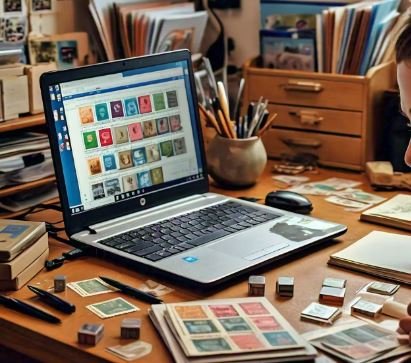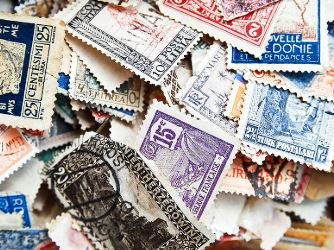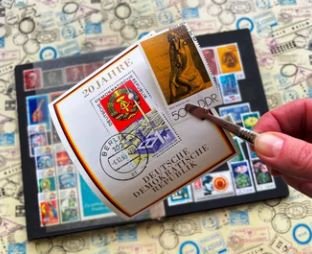Stamp collecting, a beloved hobby for centuries, has seen significant transformations in recent years, particularly due to the rise of digital communication. The shift towards online interactions has had a profound effect on how collectors acquire, trade, and connect over stamps.
While this digital revolution has unlocked new possibilities for stamp enthusiasts, it has also contributed to the decline of traditional practices within the hobby. In this article, we’ll explore how digital communication is reshaping stamp collecting, offering both exciting opportunities and posing challenges that collectors must navigate.

1. Digital Communication: A Gateway to Global Connections
One of the most exciting aspects of the impact of digital communication on stamp collecting is how it has dramatically expanded the community of collectors. In the past, collectors often relied on local clubs or face-to-face meetings to exchange knowledge and stamps. However, with the advent of online platforms, stamp collectors can now connect with others around the world instantly.
Unlocking New Possibilities:
- Global Reach: Thanks to online forums, social media, and auction sites, collectors can now buy, sell, and trade stamps from all corners of the globe. This has made it possible for enthusiasts to find rare and hard-to-find stamps that would have been nearly impossible to obtain in the past.
- Networking Opportunities: Digital communication has facilitated the growth of online stamp communities. Enthusiasts from diverse backgrounds can share tips, showcase their collections, and even collaborate on research projects.
Overcoming the Decline of Traditional Practices:
- Loss of In-Person Interaction: While digital communication offers vast networking opportunities, the decline of face-to-face interaction has led to the erosion of some traditional practices in stamp collecting. Local clubs and gatherings are no longer as central to the hobby, which means that the camaraderie and personal connections that once defined the community may be fading.

2. E-Commerce and Online Marketplaces: Revolutionizing Stamp Buying and Selling
The rise of e-commerce has been one of the most significant contributors to the impact of digital communication on stamp collecting. Online marketplaces such as eBay, Delcampe, and other specialized stamp-selling websites have made it easier than ever to buy and sell stamps without ever leaving your home.
Unlocking New Possibilities:
- Access to a Larger Market: Collectors now have access to a broader range of stamps, from vintage rarities to new releases. With the convenience of online purchasing, it’s easier than ever to add valuable pieces to a collection.
- Price Transparency: The digital marketplace allows buyers to compare prices and make more informed purchasing decisions. This transparency benefits both buyers and sellers, helping to ensure fair market value for stamps.
Overcoming the Decline of Traditional Practices:
- Loss of Local Dealers: The proliferation of online marketplaces has contributed to the decline of traditional brick-and-mortar stamp shops. Many physical dealers have struggled to adapt to the digital age, and some have been forced to close their doors, taking with them the personal touch and expertise that was once a hallmark of stamp collecting.
3. Digital Tools and Catalogs: Enhancing Knowledge and Preservation
Digital communication has not only changed how collectors connect, but it has also enhanced their knowledge base. Online catalogs, digital resources, and databases now make it possible for collectors to access information about stamps instantly.
Unlocking New Possibilities:
- Instant Access to Information: With the vast array of digital tools available, collectors can quickly access detailed information on stamp issues, values, and history. Websites like StampWorld or the Scott Catalog offer comprehensive digital catalogs that make research easy and efficient.
- Virtual Collections and Preservation: Digital tools also help preserve stamps for posterity. Collectors can use high-quality scanners to digitize their collections, ensuring that their valuable stamps are protected and archived in a digital format.
Overcoming the Decline of Traditional Practices:
- Diminishing Physical Catalogs: In the past, collectors would pore over physical stamp catalogs to identify and assess the value of stamps. With the rise of digital tools, the use of printed catalogs has significantly declined. While digital catalogs are efficient, the tactile experience of flipping through a physical catalog is a practice that’s slowly disappearing.

4. Social Media and Online Communities: Reviving the Social Aspect of Collecting
The Impact of Digital Communication on Stamp Collecting on Social media platforms such as Instagram, and Facebook, and specialized online communities like Reddit have become vital tools for stamp collectors. These platforms offer a space for individuals to showcase their collections, share knowledge, and interact with like-minded enthusiasts.
Unlocking New Possibilities:
- Increased Exposure: Through social media, collectors can share images of their stamps with a global audience, attracting attention from other enthusiasts, potential buyers, and even experts. Hashtags like #StampCollectors or #Philately allow users to find and connect with others in the community.
- Educational Content: Collectors and dealers use social media to educate the public, provide market updates, and showcase newly discovered stamps. This helps foster a more informed and engaged community of collectors.
Overcoming the Decline of Traditional Practices:
- Decreased Face-to-Face Learning: While social media is an excellent platform for information exchange, it lacks the personal touch and depth of knowledge that could be gained from face-to-face interactions. In-person learning from seasoned collectors or attending live auctions or stamp fairs is becoming less common as digital platforms take precedence.
5. Digital Auctions and Virtual Stamp Fairs: A New Way to Trade and Buy Rare Stamps
The Impact of Digital Communication on Stamp Collecting, online auctions and virtual stamp fairs have gained traction, especially with the disruptions caused by the COVID-19 pandemic. These platforms have allowed collectors to continue their activities from the comfort of their homes.
Unlocking New Possibilities:
- Wider Reach for Auctions: Digital communication has enabled global participation in stamp auctions. Auction houses like Sotheby’s and Christie’s have integrated online platforms where collectors can bid on rare stamps, often from distant countries, without attending in person.
- Virtual Fairs and Expos: Virtual stamp shows and fairs have become more common, providing collectors access to vendors, exhibitions, and sales events without the need for travel.
Overcoming the Decline of Traditional Practices:
- Loss of Physical Fairs: While digital stamp shows are convenient, the absence of physical events means the loss of the social atmosphere and the excitement of seeing rare stamps in person. Physical stamp fairs allowed for face-to-face negotiations and deeper connections between collectors and dealers, something digital platforms can’t fully replicate.

Stamp collecting is one of the most rewarding hobbies, offering enthusiasts the chance to explore the world’s history, culture, and artistry through tiny, often beautifully designed pieces of paper. Collecting stamps by country is an exciting and educational pursuit that opens the door to a wealth of knowledge, from rare commemorative issues to international postal systems read more.
Conclusion
The impact of digital communication on stamp collecting: unlocking new possibilities and overcoming the decline of traditional practices has fundamentally changed the way enthusiasts engage with the hobby. Digital tools, online communities, and e-commerce platforms have opened doors to new opportunities for collectors, from global networking to instant access to information. However, this digital shift has also contributed to the decline of traditional practices, such as face-to-face interactions, physical stamp shops, and printed catalogs.
As the hobby continues to evolve, collectors must find a balance between embracing the benefits of digital communication and preserving the rich traditions that have defined stamp collecting for centuries. By combining the best of both worlds—technology and tradition—stamp collecting can thrive in the digital age, ensuring that this fascinating hobby remains accessible and enjoyable for future generations.




